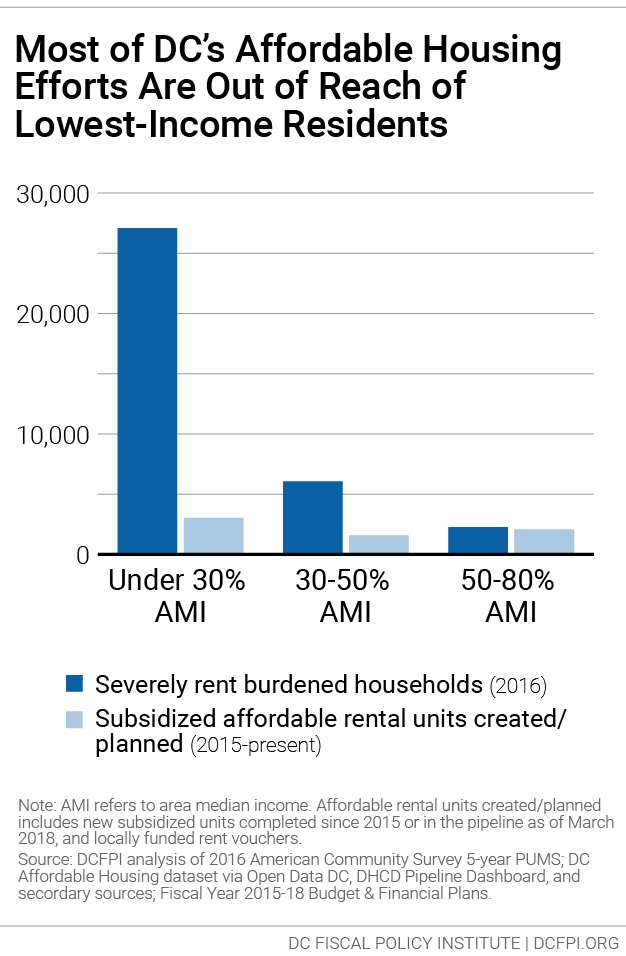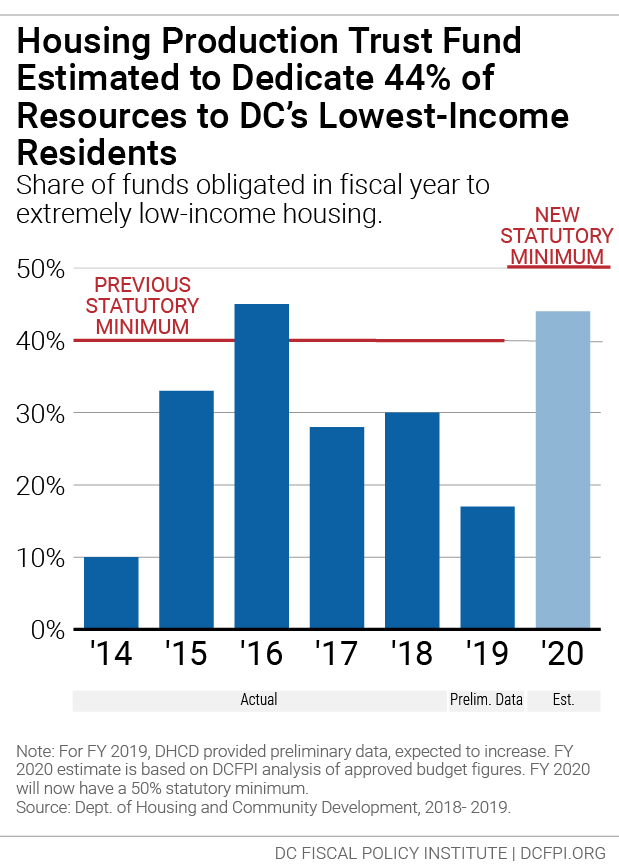DC’s enormous affordable housing challenges calls for a bold response. Having a safe and affordable place to call home is fundamental to positive life outcomes—in school performance, job retention, physical and mental health, and economic security. But for a number of reasons—a history of racist public policies, disappearing low-cost housing, and an economy with stagnant wages for those who earn the least—many people do not have that opportunity.

Creating more affordable housing is critical to addressing DC’s racial inequities. Black residents—historically shut out of homeownership opportunities and often living on low wages that reflect historical and ongoing job discrimination—bear the brunt of DC’s rising rents. Residents of color represent nine out of 10 households with the most serious housing needs—those with low-incomes who pay more than half their income for rent.
While the District’s leaders have taken steps to create and preserve affordable housing, these efforts have met only a small share of the need. Some 27,000 extremely low-income households face severe housing hardship yet the District only funded about 3,000 new rental units for these residents between 2015 and 2018 (Figure 1).
The Mayor and Council should use the fiscal year (FY) 2021 budget to put DC on a path toward completely meeting the affordable housing needs of the families who need it most.
Build More Affordable Housing
The Housing Production Trust Fund (HPTF) is DC’s primary tool for building and preserving affordable housing. DC has committed $100 million to the HPTF each year since FY 2015 and devoted $115.6 million to the HPTF in FY 2020. Yet more is needed to move towards fully meeting DC’s affordable housing needs.
- Rising land prices and construction costs, especially in higher income neighborhoods, mean that the HPTF needs additional resources simply to maintain the same level of activity. DCFPI estimated that creating the same number of new homes as in 2015 would cost more than $150 million in FY 2020.
- Meeting the affordable housing needs of DC’s low-income residents over 10 years would require an over $240 million investment in the HPTF in FY 2021, without accounting for recent shortfalls.
- Mayor Bowser acknowledged that affordable housing demand is so high that we could invest $250 million in the Housing Production Trust Fund.
An investment of $250 million in the Housing Production Trust Fund would help build at least 1,500 affordable homes for DC residents.
Preserve More Affordable Housing
The Affordable Housing Preservation Fund (AHPF) provides financing to preserve, acquire and rehabilitate DC’s affordable housing stock. Preservation costs just half to two-thirds of what new construction costs and AHPF managers have leveraged $3.3 in private and philanthropic dollars for every $1 of District funding, and the financing recycles – as projects repay, the dollars go toward preserving more affordable homes. The FY 2020 budget provided $11.8 million for affordable housing preservation. DC should support the Preservation Fund at even higher levels to help ensure native Washingtonians, especially Black and brown residents, are able to stay in their communities.
An investment of $15 million in the Affordable Housing Preservation Fund would preserve 1,350 affordable homes. This investment in the AHPF should not come at the expense of the HPTF.
Help Families Pay Rent
DC’s Local Rent Supplement Program (LRSP) provides rental assistance to help cover the difference between rents that low-income families can pay and the rents they face. One component of LRSP operates by providing vouchers to households to help them afford private-market apartments. In addition, some LRSP subsidies are tied to buildings developed with the HPTF to ensure that these units reach the lowest-income families.

Providing more LSRP is key to meeting the housing needs of extremely low-income residents. Without rental subsidies, projects built through HPTF generally are not affordable to extremely low-income families. Changes adopted in the FY 2020 budget require 50 percent of HPTF resources be used to serve DC’s poorest families (those with incomes up to $36,400 for a family of four). The District had met the prior targeting requirement—percent for the lowest-income families—only once in the past 5 years (Figure 2). The FY 2020 budget includes $7.2 million for LRSP tied to projects, which should assist the District in meeting the old targeting requirement for FY 2020.
An investment of approximately $24 million in LRSP would ensure that 50 percent of HPTF resources (if funded at $250 million) serve extremely low-income households, while also making up for recent shortfalls in serving this group. The city should match this funding with an additional $10.4 million to provide tenant vouchers to 500 families on the DC Housing Authority wait list.
While substantial, even this funding is far below what is needed in the long-term. Putting DC on a 10-year path to providing affordable housing to all extremely low-income households would require over $60 million for LRSP in 2021.
Repair and Preserve Public Housing
Public housing is a key source of stable, affordable housing for over 7,000 of the District’s extremely low-income families. And over 90 percent of these public housing residents are Black. Due to federal underfunding, four out of five public housing units in DC are in need of significant repairs, and many residents live in deplorable conditions. In recent years, the District has committed some local funding to support public housing repairs, including $19 million in FY 2018, $3.25 million in FY 2019, and $24.5 million in FY 2020. Yet the DC Housing Authority, which owns and manages public housing reported that its immediate repair needs are much higher—$343 million—while long-term repairs will require close to $2.5 billion. The DC Housing Authority is in the middle of implementing a “repositioning” plan that could risk housing stability and protections for current public housing tenants after redevelopment. The Mayor and DC Council should consider ways to preserve DC’s public housing stock without compromising the housing needs of its existing residents.
An investment of $60 million in FY 2021 would help repair and preserve DC’s public housing, so that residents have a safe place to call home.
